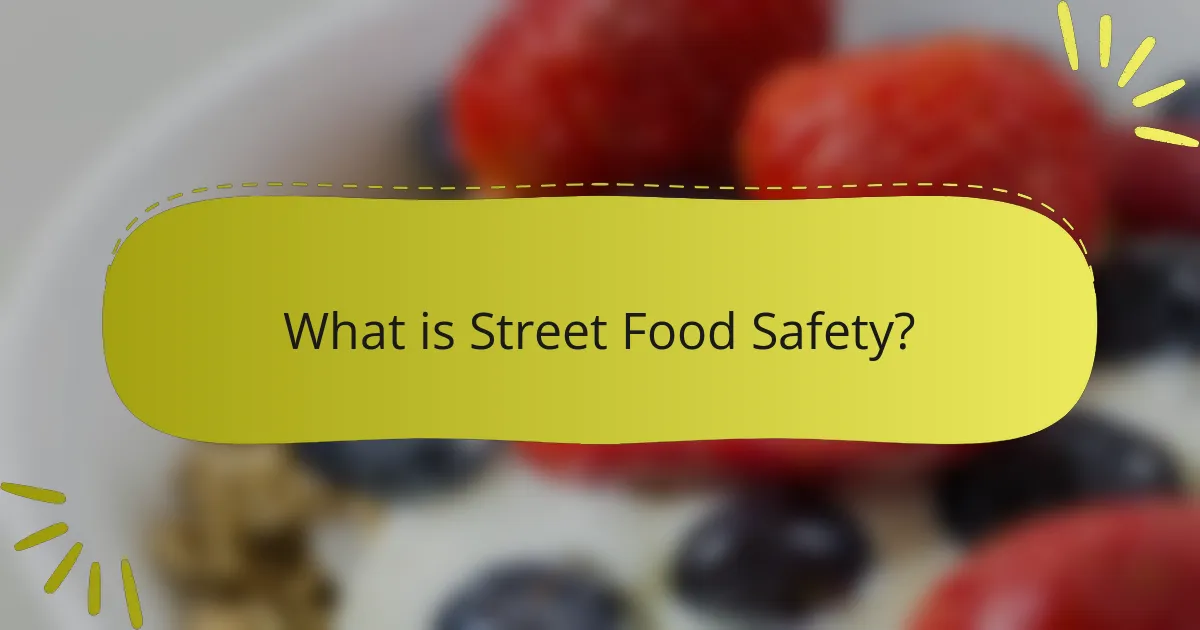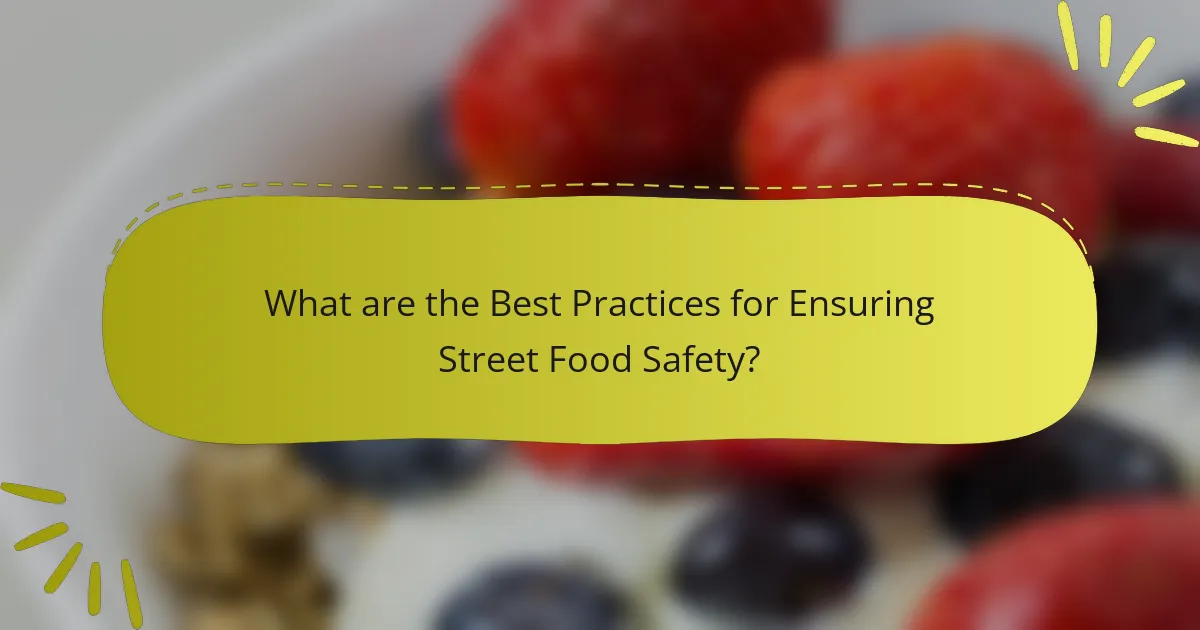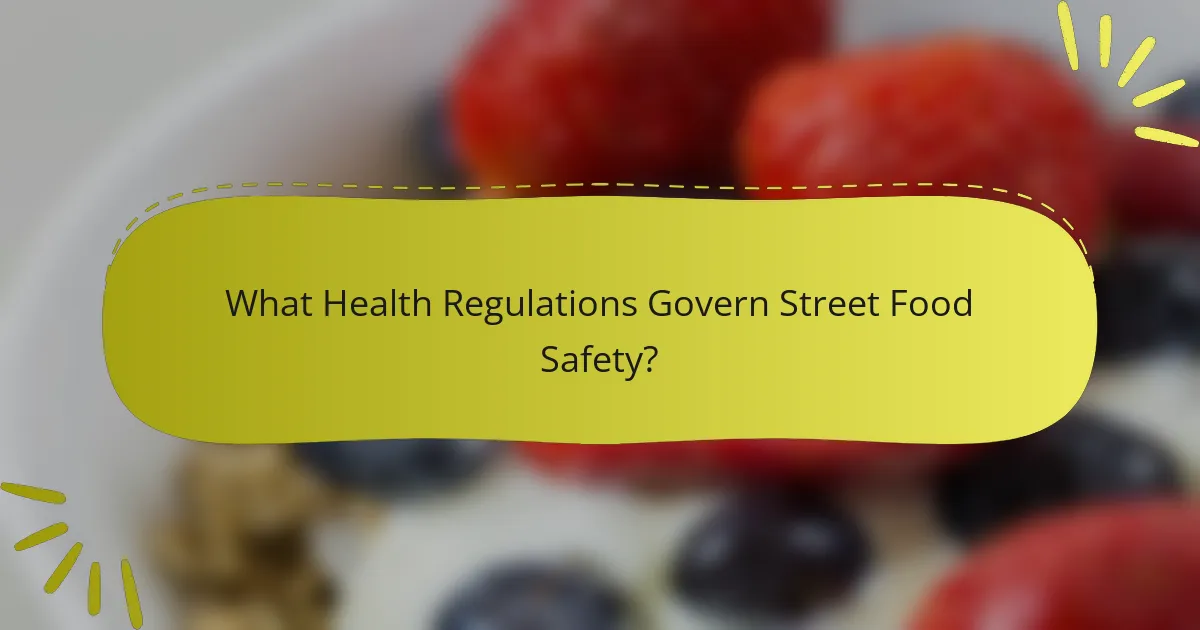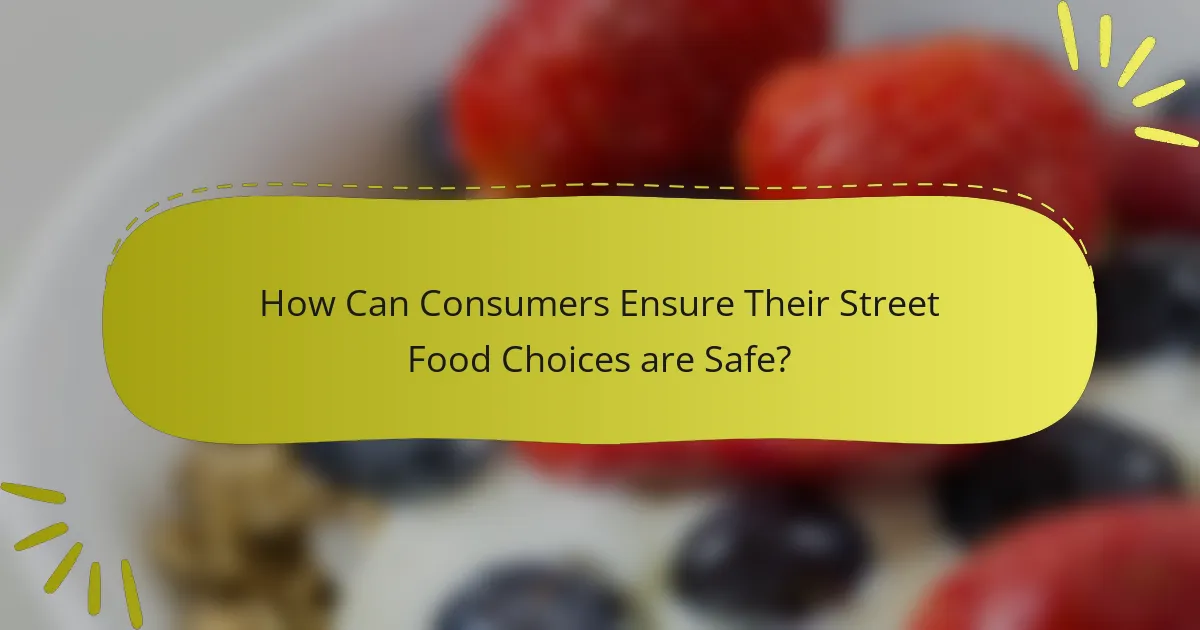Street food safety encompasses the essential practices that ensure safe preparation and consumption of street food, focusing on hygiene, temperature control, and prevention of cross-contamination. The article outlines best practices for food handling, cleanliness, and temperature regulation, emphasizing the importance of regular health inspections and compliance with health regulations to mitigate foodborne illness risks. It also highlights the role of consumer awareness in making safe food choices, including observing vendor hygiene and ingredient freshness. By adhering to established safety standards and guidelines, both vendors and consumers can significantly reduce the likelihood of health issues associated with street food consumption.

What is Street Food Safety?
Street food safety refers to the practices that ensure the safe preparation and consumption of street food. It involves maintaining proper hygiene, cooking food at safe temperatures, and preventing cross-contamination. According to the World Health Organization, unsafe street food can lead to foodborne illnesses. Proper food handling and storage are essential to mitigate these risks. Regular health inspections of street food vendors help enforce safety standards. Consumer awareness about food safety can also play a crucial role in preventing health issues.
Why is Street Food Safety important for consumers?
Street food safety is important for consumers because it directly impacts their health and well-being. Unsafe street food can lead to foodborne illnesses, which affect millions globally each year. According to the World Health Organization, an estimated 600 million people fall ill after eating contaminated food. Proper food handling, hygiene practices, and safe cooking temperatures are essential to prevent these risks. Consumers rely on vendors to adhere to health regulations to ensure their meals are safe. Awareness of food safety practices empowers consumers to make informed choices when purchasing street food. Ultimately, prioritizing street food safety protects public health and fosters trust in food vendors.
What are the potential risks associated with street food?
Potential risks associated with street food include foodborne illnesses, contamination, and poor hygiene practices. Foodborne illnesses arise from bacteria like Salmonella and E. coli, which can thrive in improperly stored or prepared food. Contamination can occur from unclean cooking utensils or contaminated water used in food preparation. Poor hygiene practices by vendors can lead to the spread of pathogens. According to the World Health Organization, street food contributes to a significant percentage of foodborne disease outbreaks. Consumers should be aware of these risks and choose vendors that demonstrate good hygiene and food safety practices.
How can street food safety impact public health?
Street food safety significantly impacts public health by preventing foodborne illnesses. Unsafe food handling practices can lead to contamination, resulting in outbreaks of diseases such as Salmonella and E. coli. According to the World Health Organization, foodborne and waterborne diseases cause an estimated 600 million illnesses globally each year. Ensuring that street food vendors follow health regulations reduces these risks. Proper cooking temperatures and hygiene practices are essential for food safety. Consumers also play a role by being aware of food safety standards. Public health initiatives can educate both vendors and consumers on safe practices. This collaborative effort can enhance community health outcomes.
What are the key components of street food safety?
Key components of street food safety include proper food handling, hygiene practices, and safe cooking temperatures. Proper food handling prevents cross-contamination. Vendors must wash hands frequently and use clean utensils. Hygiene practices involve maintaining clean cooking areas and using sanitized equipment. Safe cooking temperatures ensure that food is cooked thoroughly to kill harmful bacteria. According to the World Health Organization, cooking food to at least 75°C (167°F) reduces foodborne illnesses. Regular health inspections also play a crucial role in ensuring compliance with safety regulations.
What role do hygiene practices play in street food safety?
Hygiene practices are crucial for ensuring street food safety. They prevent contamination and reduce the risk of foodborne illnesses. Proper handwashing, clean cooking surfaces, and safe food storage are essential hygiene measures. A study by the World Health Organization indicates that poor hygiene is a leading cause of foodborne diseases globally. Implementing hygiene practices can significantly lower the incidence of such diseases. Regular training for street food vendors on hygiene can improve food safety standards. Adhering to these practices protects both consumers and vendors.
How does food storage affect street food safety?
Food storage significantly impacts street food safety by influencing the growth of harmful microorganisms. Proper storage temperatures prevent bacterial growth, which can lead to foodborne illnesses. For example, food should be kept at or below 4°C (39°F) to inhibit pathogen development. Additionally, hot foods must be maintained at temperatures above 60°C (140°F) to ensure safety.
Improper storage, such as keeping food at room temperature, increases the risk of contamination. According to the World Health Organization, unsafe food handling practices contribute to approximately 600 million cases of foodborne diseases annually.
Using appropriate storage containers also plays a crucial role in preventing cross-contamination. Clean and sanitized storage areas further enhance food safety by minimizing the risk of foodborne pathogens. Thus, effective food storage practices are vital for ensuring the safety of street food.

What are the Best Practices for Ensuring Street Food Safety?
The best practices for ensuring street food safety include proper food handling, cleanliness, and temperature control. Vendors should wash hands frequently and use gloves when handling food. They must maintain clean cooking areas and equipment. Food should be stored at safe temperatures to prevent bacterial growth. Hot foods should be kept above 140°F, while cold foods must be below 40°F. Ingredients should be sourced from reputable suppliers. Regular inspections by health authorities can help maintain safety standards. Educating consumers about safe food choices is also crucial. These practices reduce the risk of foodborne illnesses.
How can vendors maintain hygiene in street food preparation?
Vendors can maintain hygiene in street food preparation by implementing strict sanitation practices. Regular handwashing with soap and water is essential before handling food. Vendors should use clean utensils and equipment to prevent cross-contamination. Food should be stored at safe temperatures to inhibit bacterial growth. Additionally, vendors must ensure that food is cooked thoroughly. Using disposable gloves when serving food can further enhance hygiene. Regular cleaning of the food preparation area is necessary to eliminate contaminants. Following local health regulations and guidelines also supports safe food practices.
What cleaning protocols should street food vendors follow?
Street food vendors should follow strict cleaning protocols to ensure food safety. They must clean and sanitize food preparation surfaces regularly. This includes using approved sanitizing solutions and following the manufacturer’s instructions. Vendors should wash hands frequently with soap and water, especially after handling raw food. They need to keep utensils and equipment clean and stored properly. Trash should be disposed of promptly to avoid contamination. Vendors should also ensure that their food carts are cleaned daily. Regular inspections by health authorities can help maintain compliance with local regulations. These practices help prevent foodborne illnesses and protect consumer health.
How often should food preparation areas be sanitized?
Food preparation areas should be sanitized after each use. This practice helps prevent cross-contamination and foodborne illnesses. Additionally, surfaces should be sanitized when switching between different food items, especially raw and cooked foods. The Centers for Disease Control and Prevention (CDC) recommends frequent sanitization to maintain hygiene standards. Regular cleaning and sanitization also enhance food safety compliance in food service operations.
What are the recommended food handling techniques for street food?
Recommended food handling techniques for street food include maintaining proper hygiene, cooking food thoroughly, and ensuring safe storage. Vendors should wash hands regularly with soap and clean water. They must also use gloves when handling ready-to-eat foods. Cooking temperatures should reach at least 165°F (74°C) to kill harmful bacteria. Food should be kept at safe temperatures, below 40°F (4°C) for cold items and above 140°F (60°C) for hot items. Cross-contamination must be avoided by using separate utensils for raw and cooked foods. Regular cleaning of food preparation areas is essential. These practices help prevent foodborne illnesses and ensure consumer safety.
What are the guidelines for cooking temperatures and times?
Cooking temperatures and times are critical for food safety. The USDA recommends cooking poultry to an internal temperature of 165°F (74°C). Ground meats should reach at least 160°F (71°C). Whole cuts of beef, pork, lamb, and veal need to be cooked to a minimum of 145°F (63°C) with a rest time of three minutes. Seafood should be cooked to an internal temperature of 145°F (63°C). These guidelines help prevent foodborne illnesses. The CDC states that proper cooking kills harmful bacteria. Following these temperatures ensures food is safe for consumption.
How can cross-contamination be prevented in street food stalls?
To prevent cross-contamination in street food stalls, implement strict hygiene practices. Use separate utensils for raw and cooked foods. Ensure that food handlers wash hands frequently with soap and water. Maintain proper food storage temperatures to inhibit bacterial growth. Regularly clean surfaces and equipment to eliminate contaminants. Avoid using the same cutting boards for different food types. Provide training for staff on safe food handling practices. Studies show that adherence to these protocols significantly reduces foodborne illnesses.

What Health Regulations Govern Street Food Safety?
Health regulations governing street food safety include local health codes and food safety standards. These regulations ensure that food vendors maintain hygiene and safe food handling practices. Compliance with these regulations helps prevent foodborne illnesses. For example, vendors must often obtain permits and undergo inspections. Regulations typically cover food storage temperatures, sanitation, and employee health. The U.S. Food and Drug Administration (FDA) provides guidelines that many local jurisdictions adopt. These guidelines include the Food Code, which outlines best practices for food safety. Regular training for food handlers is also mandated in many areas.
What are the local health regulations for street food vendors?
Local health regulations for street food vendors vary by location. Typically, vendors must obtain a health permit from the local health department. They are required to follow food safety practices, including proper food storage and handling. Vendors must also maintain cleanliness in their food preparation areas. Regular inspections by health officials are standard to ensure compliance. Additionally, some areas mandate food safety training for vendors. Compliance with local regulations helps prevent foodborne illnesses. These regulations are enforced to protect public health and ensure safe food consumption.
How do health inspections influence street food safety?
Health inspections significantly enhance street food safety by ensuring compliance with hygiene standards. These inspections assess food handling practices, sanitation, and food storage conditions. Regular inspections deter vendors from neglecting safety protocols. In areas with frequent inspections, foodborne illness rates tend to decrease. A study by the Centers for Disease Control and Prevention found that food establishments with regular inspections had a 20% lower incidence of foodborne illnesses. Inspections also educate vendors on safe food practices, fostering a culture of safety. Ultimately, health inspections create accountability, improving overall public health outcomes related to street food.
What permits are required for street food vendors to operate legally?
Street food vendors typically require several permits to operate legally. These often include a business license, health department permit, and food handler’s permit. A business license allows vendors to legally operate their business in a specific location. The health department permit ensures compliance with local health regulations. The food handler’s permit certifies that the vendor has received training in safe food handling practices.
Additional permits may be necessary based on local regulations. For example, some areas require a mobile food vendor permit or a special event permit. Vendors should also check zoning laws to ensure they are allowed to operate in their chosen location. Compliance with these permits helps ensure food safety and protects public health.
What is the role of government agencies in street food safety?
Government agencies play a critical role in ensuring street food safety. They establish health regulations that street food vendors must follow. These regulations cover food handling, preparation, and storage practices. Agencies conduct inspections to enforce compliance with these standards. They also provide training programs for vendors on safe food practices. Additionally, government agencies may issue permits that ensure vendors meet health requirements. Public health campaigns are often supported by these agencies to raise consumer awareness about food safety. These efforts collectively help reduce foodborne illnesses associated with street food.
How do agencies enforce health regulations for street food?
Agencies enforce health regulations for street food through inspections, permits, and compliance checks. They conduct regular inspections to assess food safety practices. These inspections evaluate hygiene, food handling, and storage conditions. Agencies require vendors to obtain permits to operate legally. This process includes training on health regulations and safety standards. Violations identified during inspections can lead to fines or permit revocation. Additionally, agencies may provide educational resources to improve vendor compliance. Studies show that regular inspections significantly reduce foodborne illness outbreaks linked to street food.
What resources are available for educating vendors on health regulations?
Resources available for educating vendors on health regulations include government websites, training programs, and industry associations. Government websites often provide comprehensive guidelines on local health regulations. For example, the U.S. Food and Drug Administration (FDA) offers resources on food safety standards. Training programs are available through organizations like ServSafe, which provides certification courses for food handlers. Industry associations, such as the National Restaurant Association, offer resources and workshops for vendors. These resources ensure that vendors understand compliance and best practices in food safety.

How Can Consumers Ensure Their Street Food Choices are Safe?
Consumers can ensure their street food choices are safe by observing hygiene practices and food preparation standards. They should choose vendors who maintain clean cooking areas. Observing food handling practices can indicate safety; for instance, vendors wearing gloves and hairnets are preferable. Consumers should also check the freshness of ingredients. Hot food should be served steaming, while cold items should be properly refrigerated. If food appears undercooked or improperly stored, it is best to avoid it. Additionally, consumers can ask vendors about food sourcing and preparation methods. Research indicates that street food vendors adhering to health regulations significantly reduce foodborne illness risks.
What should consumers look for when choosing street food vendors?
Consumers should look for cleanliness and food safety practices when choosing street food vendors. Cleanliness includes the vendor’s personal hygiene and the condition of their cooking equipment. Vendors should wear gloves and hairnets while preparing food. The food stall should be free of pests and debris. Consumers should also check for proper food storage temperatures. Hot food should be held above 140°F and cold food below 40°F. Observing the vendor’s popularity can indicate food quality. Busy vendors often have fresher ingredients due to higher turnover. Licensing and permits should be displayed, showing compliance with local health regulations. These factors help ensure a safer street food experience.
How can consumer awareness of food safety impact vendor practices?
Consumer awareness of food safety significantly influences vendor practices. When consumers are informed about food safety, they demand higher standards. This pressure encourages vendors to adopt safer food handling and preparation methods. Increased awareness can lead to more rigorous compliance with health regulations. Vendors may invest in better training for staff to meet consumer expectations. Studies show that businesses with transparent food safety practices often see increased customer loyalty. A 2020 survey indicated that 75% of consumers would choose vendors with visible food safety measures. Consequently, consumer awareness drives vendors to enhance their practices for competitive advantage.
What signs indicate a street food vendor is following safety protocols?
Signs that indicate a street food vendor is following safety protocols include visible cleanliness and proper hygiene practices. The vendor should wear gloves and a clean apron while handling food. Food should be stored at appropriate temperatures to prevent spoilage. Cooking equipment must be sanitized regularly. The vendor should have a valid health permit displayed prominently. There should be no signs of pest infestations in the area. Proper waste disposal methods should be in place. These signs collectively demonstrate adherence to health regulations and consumer safety standards.
What are some common misconceptions about street food safety?
Street food safety is often misunderstood. One common misconception is that all street food is unsafe to eat. In reality, many street vendors follow strict hygiene practices. Another misconception is that food prepared in restaurants is always safer than street food. Studies show that foodborne illnesses can occur in both settings. People often believe that hot food is safe while cold food is not. However, improper handling of hot food can also lead to contamination. Lastly, some think that street food is only unhealthy. Many vendors offer nutritious options made from fresh ingredients. These misconceptions can lead to unnecessary fear and limit people’s culinary experiences.
Why do some people believe street food is inherently unsafe?
Some people believe street food is inherently unsafe due to concerns about hygiene and food handling practices. Street food vendors often operate in open-air environments, which can expose food to contaminants. Limited access to clean water for washing hands and utensils raises further health risks. Additionally, the rapid turnover of food items can lead to improper cooking or storage temperatures. According to a study published in the Journal of Food Protection, foodborne illnesses are more prevalent in street food settings compared to formal restaurants. These factors contribute to the perception of street food as a potential health hazard.
How can education help dispel myths about street food safety?
Education can effectively dispel myths about street food safety by providing accurate information. It equips consumers with knowledge about food handling practices and safety standards. Educational programs can highlight the importance of hygiene and proper cooking techniques used by street vendors. Research shows that informed consumers are more likely to trust street food when they understand safety protocols. For example, a study conducted by the Food Safety Authority found that consumer education reduced foodborne illness rates by 30%. This demonstrates that targeted education can change perceptions and improve public health outcomes.
What are practical tips for enjoying street food safely?
To enjoy street food safely, choose vendors with high turnover and visible cleanliness. Freshly cooked food reduces the risk of foodborne illnesses. Observe food handling practices; vendors should wear gloves and use utensils. Avoid raw or undercooked items, as they can harbor bacteria. Drink bottled or sealed beverages to prevent contamination. Look for food that is served hot, as this indicates proper cooking temperatures. Pay attention to local health ratings if available; higher ratings suggest better hygiene practices. Finally, trust your instincts; if a vendor seems unsanitary or untrustworthy, choose another option.
How can consumers prepare for potential food safety risks when eating street food?
Consumers can prepare for potential food safety risks when eating street food by following specific guidelines. First, they should choose vendors with high customer turnover. This indicates fresh ingredients and proper food handling. Second, consumers should observe food preparation practices. Vendors should wear gloves and maintain clean cooking areas. Third, checking for proper food storage is crucial. Hot foods should be kept hot, and cold foods should be kept cold. Fourth, consumers should avoid raw or undercooked items. These foods carry a higher risk of foodborne illnesses. Fifth, drinking bottled or sealed beverages is safer than consuming tap water. This reduces the risk of contamination. Lastly, consumers can carry hand sanitizer for additional hygiene. These practices can significantly lower the chances of food safety issues.
What are the best practices for reporting unsafe street food conditions?
To report unsafe street food conditions, individuals should gather specific details about the incident. This includes the location, time, and nature of the unsafe conditions observed. It is essential to take photographs if possible, as visual evidence can support the report. Individuals should contact local health authorities or food safety agencies to report the issue. Providing as much information as possible helps authorities address the situation effectively. Many regions have hotlines or online platforms for reporting food safety concerns. Prompt reporting can prevent potential health risks to others. According to the World Health Organization, foodborne illnesses affect millions globally, highlighting the importance of reporting unsafe food practices.
The main entity of this article is street food safety, which encompasses the practices and regulations necessary for the safe preparation and consumption of street food. The article highlights the importance of hygiene, proper food handling, and temperature control to prevent foodborne illnesses, as well as the role of health inspections and consumer awareness in ensuring safety standards. Key components include best practices for vendors, the impact of hygiene on public health, and guidelines for consumers to make informed choices. Additionally, it addresses common misconceptions about street food safety and emphasizes the collaborative effort needed to enhance community health outcomes.